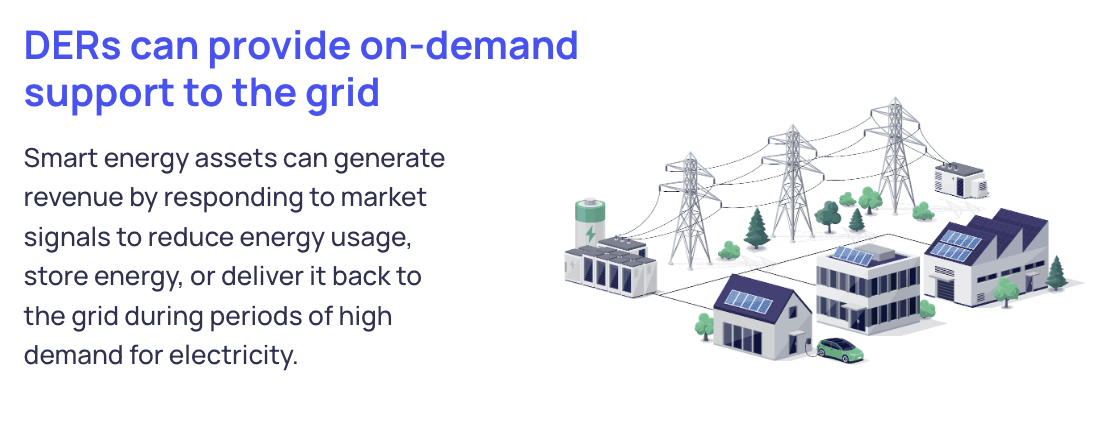Leap
Our Investment in Leap
Replacing fossil fuel peaker plants with connected energy assets
Peaker plants, which run on natural gas and operate at a moment’s notice during periods of peak electricity demand, have been portrayed by their proponents as a necessary “bridge fuel” until a resilient renewable infrastructure is in place. Because of the intermittency of renewable energy sources, like wind and solar, or simply due to excess demand, utilities and grid operators fire up peaker plants when they are unable to power the energy grid sufficiently. Although they operate infrequently, peakers are some of the least efficient power plants in use, and a source of pernicious greenhouse gasses and harmful pollutants, like nitrogen oxides, which typically have the heaviest impact on surrounding low-income communities.
Helping to curb the energy grid’s dependence on peaker plants and make it more resilient, Leap, founded in San Francisco, California, creates “virtual power plants,” by connecting grid operators in energy markets with a network of smart energy assets (a.k.a “Distributed Energy Resources” or DERs). These assets, which may include battery storage, EV chargers, HVAC and other connected devices whose electricity use can be managed digitally, can be used to supply or conserve electricity to the grid during periods of heightened demand.
Leap has created a network of connected energy assets, which can be used to provide flexible support to the grid during periods of peak demand.
Leap has developed an elegant and scalable solution in the way of an API that seamlessly integrates with DERs to manage their demand response and other grid flexibility services. The company incents DER owners — including both commercial and residential partners — to participate in its marketplace through proceeds that come from the sale of energy and capacity to the wholesale energy market. Having participated in the company’s 2021 Series B, MCJ Collective is excited to share its investment in Leap — founded by CEO Thomas Folker and COO Remco van den Elzen — as it builds infrastructure for reliable renewable energy everywhere.
Leap facilitates ‘win-win’ outcomes for both sides of its marketplace.
What is Leap?
Leap is a software platform that connects DERs to energy markets, making it easy for smart energy technology owners and operators to earn revenue by reducing or shifting their electricity consumption when the grid is strained. The company’s underlying technology is its Universal API, requiring only a few lines of code on the part of DER owners and effectively turning these connected assets into autonomous smart energy traders.
Leap enables smart devices to respond to market pricing signals representing the real-time needs of the electric grid, and get paid for it. By aggregating the flexible capacity across many different energy devices, Leap and its partners can provide meaningful support to the grid and empower end customers to become active participants in their energy systems.
Why did we invest?
Compelling Founder-Market Fit
With a 14-year career in the renewable energy sector, Thomas, prior to founding Leap, specialized in renewable project finance for several large solar and offshore wind projects in Europe. In addition, he developed multiple utility scale solar projects across Europe including Italy, France and Spain. He has advised several utility companies on their renewable energy strategies and he was instrumental in the establishment of the first UK based solar power purchasing agreement (PPA) offering for the residential market. He also led business development at global solar & battery provider Enphase Energy.
An inveterate entrepreneur, Remco has founded two companies in the software and market data space. One of his former companies, Distimo, was acquired in 2014 by App Annie, where he served as an executive in account management and business development.
Impressive Traction & Scalability
With 35K devices enrolled on the platform, 390 megawatts under management, and 30+ platform partners — including the likes of, Stem, Sunrun, and Resideo — Leap has grown over 13x over the past two years, and has delivered over 10,000 MWh of clean energy to the grid. As renewables continue to increase their share of the energy mix, the company is on track to become a leader in DER market access.
While the expanding deployment of renewable energy is a key driver propelling Leap’s value proposition, Leap’s technology has demonstrated its importance in the extreme weather events that are occurring with greater frequency and severity due to climate change. During the summer heat wave that hit California in 2021, Leap dispatched energy from more than 10,000 commercial and residential sites representing over 375 MWh of electricity to help support the grid and avoid blackouts. This is one case exemplifying how Leap represents not only a critical component of the renewable energy infrastructure, but also a key solution for adapting to the climate crisis.



